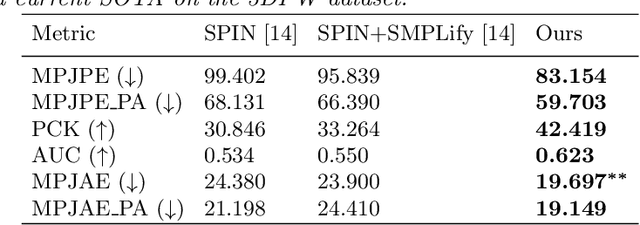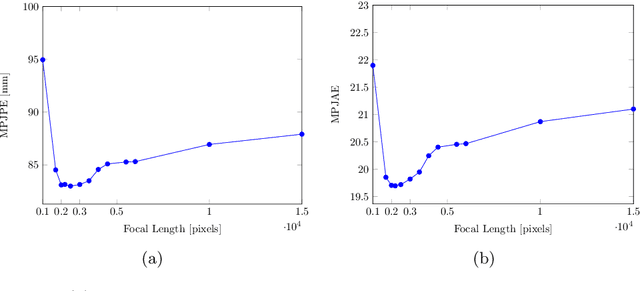Lior Fritz
Beyond Weak Perspective for Monocular 3D Human Pose Estimation
Sep 14, 2020



Abstract:We consider the task of 3D joints location and orientation prediction from a monocular video with the skinned multi-person linear (SMPL) model. We first infer 2D joints locations with an off-the-shelf pose estimation algorithm. We use the SPIN algorithm and estimate initial predictions of body pose, shape and camera parameters from a deep regression neural network. We then adhere to the SMPLify algorithm which receives those initial parameters, and optimizes them so that inferred 3D joints from the SMPL model would fit the 2D joints locations. This algorithm involves a projection step of 3D joints to the 2D image plane. The conventional approach is to follow weak perspective assumptions which use ad-hoc focal length. Through experimentation on the 3D Poses in the Wild (3DPW) dataset, we show that using full perspective projection, with the correct camera center and an approximated focal length, provides favorable results. Our algorithm has resulted in a winning entry for the 3DPW Challenge, reaching first place in joints orientation accuracy.
Joint Visual-Textual Embedding for Multimodal Style Search
Jun 15, 2019



Abstract:We introduce a multimodal visual-textual search refinement method for fashion garments. Existing search engines do not enable intuitive, interactive, refinement of retrieved results based on the properties of a particular product. We propose a method to retrieve similar items, based on a query item image and textual refinement properties. We believe this method can be leveraged to solve many real-life customer scenarios, in which a similar item in a different color, pattern, length or style is desired. We employ a joint embedding training scheme in which product images and their catalog textual metadata are mapped closely in a shared space. This joint visual-textual embedding space enables manipulating catalog images semantically, based on textual refinement requirements. We propose a new training objective function, Mini-Batch Match Retrieval, and demonstrate its superiority over the commonly used triplet loss. Additionally, we demonstrate the feasibility of adding an attribute extraction module, trained on the same catalog data, and demonstrate how to integrate it within the multimodal search to boost its performance. We introduce an evaluation protocol with an associated benchmark, and compare several approaches.
Generating Diverse and Informative Natural Language Fashion Feedback
Jun 15, 2019



Abstract:Recent advances in multi-modal vision and language tasks enable a new set of applications. In this paper, we consider the task of generating natural language fashion feedback on outfit images. We collect a unique dataset, which contains outfit images and corresponding positive and constructive fashion feedback. We treat each feedback type separately, and train deep generative encoder-decoder models with visual attention, similar to the standard image captioning pipeline. Following this approach, the generated sentences tend to be too general and non-informative. We propose an alternative decoding technique based on the Maximum Mutual Information objective function, which leads to more diverse and detailed responses. We evaluate our model with common language metrics, and also show human evaluation results. This technology is applied within the ``Alexa, how do I look?'' feature, publicly available in Echo Look devices.
Simplified End-to-End MMI Training and Voting for ASR
Jul 16, 2017



Abstract:A simplified speech recognition system that uses the maximum mutual information (MMI) criterion is considered. End-to-end training using gradient descent is suggested, similarly to the training of connectionist temporal classification (CTC). We use an MMI criterion with a simple language model in the training stage, and a standard HMM decoder. Our method compares favorably to CTC in terms of performance, robustness, decoding time, disk footprint and quality of alignments. The good alignments enable the use of a straightforward ensemble method, obtained by simply averaging the predictions of several neural network models, that were trained separately end-to-end. The ensemble method yields a considerable reduction in the word error rate.
 Add to Chrome
Add to Chrome Add to Firefox
Add to Firefox Add to Edge
Add to Edge